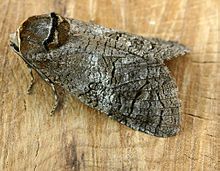Cossus cossus
| Goat moth | |
|---|---|

| |
| Scientific classification | |
| Domain: | Eukaryota |
| Kingdom: | Animalia |
| Phylum: | Arthropoda |
| Class: | Insecta |
| Order: | Lepidoptera |
| Family: | Cossidae |
| Genus: | Cossus |
| Species: | C. cossus
|
| Binomial name | |
| Cossus cossus | |
| Synonyms | |
| |
Cossus cossus, the goat moth, is a moth of the family Cossidae. It is found in Northern Africa, Asia and Europe.
Biology
This is a large heavy moth with a wingspan of 68–96 mm. The wings are greyish brown and marked with fine dark cross lines. The moth flies from April to August depending on the location.
The caterpillars have a red/purple stripe across the back and a black head. They reach a length of 9–10 cm. The caterpillars feed in the trunks and branches of a wide variety of trees (see list below), taking three to five years to mature. The caterpillar holes can be found low on the stem (maximum 1.0–1.5 m above the ground). When ready to pupate the caterpillar leaves the tree to find a suitable spot.
The species prefer humid environments. Both the larva and moth have a smell reminiscent of goat, hence its name.[1]
As a food
Pliny reported in Natural History that a grub which he gives the name cossus was considered a Roman delicacy after it was fed with flour. Some writers have equated this with Cossus cossus, but Pliny specifies that his cossus is found in oak trees, which makes this identification unlikely. Pliny's cossus is more likely to have been the larva of the beetle Cerambyx heros. [2]
Recorded food plants
It has a preference for Populus, Quercus[citation needed] and Salix.
Taxonomy
Cossus balcanicus Lederer, 1863 from Bulgaria is probably a hybrid between C. cossus and Lamellocossus terebrus (Denis & Schiffermüller, 1775).
Subspecies
- Cossus cossus cossus
- Cossus cossus albescens Kitt, 1925 (Kazakhstan, Russia)
- Cossus cossus araraticus Teich, 1896 (Georgia, Azerbaijan, Turkey, Iran)
- Cossus cossus armeniacus Rothschild, 1912 (Turkey)
- Cossus cossus chinensis Rothschild, 1912 (China: Shaanxi)
- Cossus cossus dauricus Yakovlev, 2007 (Russia: Transbaikal)
- Cossus cossus dersu Yakovlev, 2009 (Russia: southern Ussuri, Primorsky Krai)
- Cossus cossus deserta Daniel, 1953 (Mongolia)
- Cossus cossus gueruenensis Friedel, 1977 (Asia Minor)
- Cossus cossus kopetdaghi Yakovlev, 2009 (Turkmenistan)
- Cossus cossus kossai Wiltshire, 1957 (Iraq, Jordan)
- Cossus cossus lucifer Grum-Grshimailo, 1891 (Tibet)
- Cossus cossus mongolicus Erschoff, 1882 (Mongolia)
- Cossus cossus omrana Wiltshire, 1957 (Iraq, Iran)
- Cossus cossus tianshanus Hua, Chou, Fang & Chen, 1990 (Kazakhstan, Kyrgyzstan, Uzbekistan, Tajikistan, Afghanistan)
- Cossus cossus uralicus Seitz, 1912 (Uralsk)
Gallery
-
Caterpillar
-
Caterpillars of different age on willow wood
-
Caterpillar (underside; head to the right)
-
Illustrated caterpillar
-
Willow with caterpillars
-
Caterpillars
-
Pupal case
-
Illustration from John Curtis's British Entomology Volume 5
-
Illustrated pupa
-
Illustrated adult
-
Mounted
Text is available under the CC BY-SA 4.0 license; additional terms may apply.
Images, videos and audio are available under their respective licenses.











